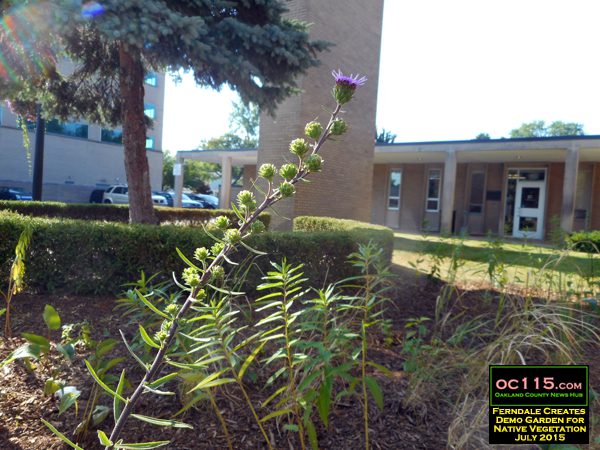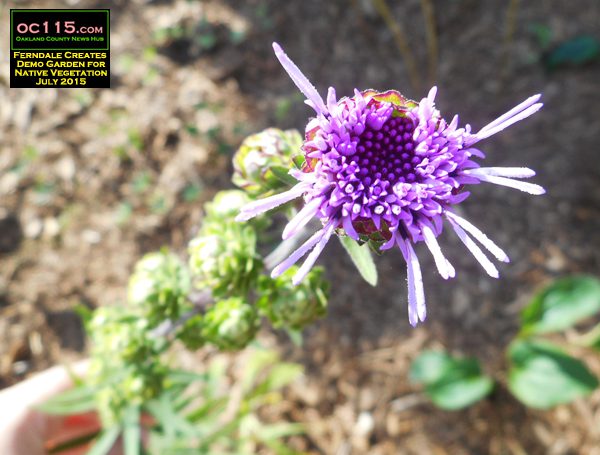 Ferndale Creates a Demo
Ferndale Creates a Demo  Garden for Native Vegetation
Garden for Native Vegetation
(Crystal A. Proxmire, July 31, 2015)
Dotted with bright yellow Black Eyed Susans and a spattering of blue Blazing Stars, the newly planted demo garden in front of Ferndale City Hall has replaced what was once a plain patch of grass.
The change in landscaping is not simply to beautify the area around the clock tower. The garden is there to educate members of the community about natural vegetation following a change in the Noxious Vegetation Ordinance in April.
The ordinance passed at the April 13 City Council meeting changes the regulations of lawns and encourages “Planned Natural Landscaping,” which “means a planned, intentional and  maintained landscaping of native plants, ornamental grasses and ground-covers, rain gardens, shrubs and trees. Non – native plants and invasive species of plants shall not be allowed. Planned natural landscaping is not intended to allow a property owner to ignore lawn care duties.” The ordinance references Michigan State University’s Native Plants and Ecosystems to guide on native plant species http://nativeplants.msu.edu/, and the City of Ferndale has prepared a webpage and a print brochure to help make residents aware of the change.
maintained landscaping of native plants, ornamental grasses and ground-covers, rain gardens, shrubs and trees. Non – native plants and invasive species of plants shall not be allowed. Planned natural landscaping is not intended to allow a property owner to ignore lawn care duties.” The ordinance references Michigan State University’s Native Plants and Ecosystems to guide on native plant species http://nativeplants.msu.edu/, and the City of Ferndale has prepared a webpage and a print brochure to help make residents aware of the change.
This means residents are not stuck with the suburban standard: turf grass.
According to the brochure “Working closely with Ferndale Council member Melanie Piana and the Ferndale Sustainability Commission, residents spent over a year creating a plan for native landscaping, resulting in an amendment to the City’s noxious vegetation ordinance. Yards featuring planned natural landscaping will now be supported and encouraged.
“The benefits are numerous. Natural landscaping is unique, distinctive, and easier to maintain – turf grass lawns, introduced by European settlers, require more care than the native prairie, woodland, and  wetland plants that once flourished here. While traditional lawns tend to look alike, natural landscaping creates a distinctive sense of place – an image that increases property values.”
wetland plants that once flourished here. While traditional lawns tend to look alike, natural landscaping creates a distinctive sense of place – an image that increases property values.”
Councilperson Piana spoke about the ordinance change in April, stating “Many Ferndale homeowners take pride in beautifying their front yards by choosing to plants, flowers and edible plants to save on water, grow their own food and attract small wildlife like birds and butterflies.”
She credited the FESC as well as the Ferndale Beautification Commission and Lillian Dean, an International Society of Arboriculture (ISA) Certified Arborist and Environmental Planning Consultant and Coordinator of the Southern Oakland County Water Authority Healthy Lawns and Gardens Program with their efforts.
Designing and planting the demo garden took about a month’s worth of research and work, and  it will take some time for the new plants to really take root and flourish.
it will take some time for the new plants to really take root and flourish.
Robert Primeau of the Ferndale Beautification Commission volunteered to do the planning, and Matt Davis of the Department of Public Works did the procurement and the planting.
Primeau is a landscape designer for the Detroit River International Wildlife Refuge. “I’m a landscape architect because I’m concerned with the challenge of restoring degraded ecosystems,” Primeau said. “A lot of times in an urban context that means attempting to restore the function of an ecosystem through helping restore the function of the ecological services that they provide, whether that’s a plants ability to slow down or purify water, or knitting together habitat for pollinators.”
In other words, the design work is not just about finding a bunch of plants that look pretty, but  creating spaces where plants can work together for goals like drainage management and attracting useful insects like butterflies and bees.
creating spaces where plants can work together for goals like drainage management and attracting useful insects like butterflies and bees.
“For some time there has been an interest in Ferndale on pollinator issues,” he said “This mirrors the concern over bee collapse on a national level. I would check out the Ferndale Monarch Project for example. Rebecca Hammond, she makes plants available for pick up that are critical for butterflies, milkweed for example.”
Hammond’s Monarch Project has helped to increase native vegetation in Ferndale to attract more butterflies. In April she wrote about the Monarch Project and how Western Market (447 W. 9 Mile) carries milkweed and other native plants.
Not only can natural landscaping feed the bees and the butterflies, several residents are growing fruits and vegetables in their front yards. In March, Lucas Harrison-Zdenek, Ferndale Permaculture did a presentation to the Ferndale Garden Club about his efforts to increase  practical use of lawn space for growing healthy, natural food. But he also talked about the time and commitment involved in tearing up the turf and tending to the garden.
practical use of lawn space for growing healthy, natural food. But he also talked about the time and commitment involved in tearing up the turf and tending to the garden.
The demo garden has a display listing the plants and pictures of them in bloom. The Ferndale Area District Library is getting in the spirit by displaying native landscaping books, and the City of Ferndale website has a list of frequently asked questions.
“We want to be a City where we don’t just pass an ordinance and do nothing with it. We want people to know about it, and be educated about what the options are,” said Ferndale Director of Communications Kara Sokol. “There are already people doing this in their yards, and we’re looking forward to see what other creative yards people come up with.”
Residents interested in creating a natural or native landscaped yard are asked to register with the City. There is no cost, and doing so will allow staff to educate people concerned about ordinance violations. Register your naturally-landscaped yard with the City of Ferndale at www.ferndalemi.gov/Services/Sustainability. Registering can also help so that the Beautification Commission can consider those properties for Beautification Awards.
If you have a yard with native landscaping and would like to be featured in an upcoming story, please message us at editor@oc115.com.













Top Bar Menu









